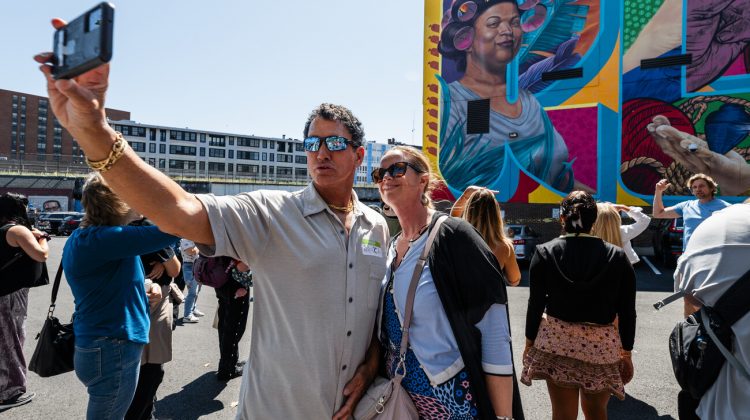LYNN — This summer, art teachers from the district joined Beyond Walls for an immersive experience to learn more about the city’s murals and even participate in the creation of three, under its program Classroom to the Streets.
Beyond Walls murals, which are created by distinguished artists from around the world, are fixated across much of Downtown Lynn.
The three most recent that were unveiled were by artists that go by the names of Dovente, Clandestinos, and Golden during the week of Aug.12.
Beyond Walls Executive Director Al Wilson said the Classroom to the Streets program is a way to increase student engagement “by leveraging the power of culturally relevant street art.
“But also, it’s kind of for the folks, or being developed by the folks, that most know that student body.”
Wilson said he hopes to work with more educators next year and that he is very honored that the district decided to work with the non profit on the project.
Assistant Director for Curriculum and Instruction Patty Kilbansky said the partnership between Beyond Walls and Lynn Public schools began in the spring, in which Executive Director Al Wilson was “immediately receptive.”
She said the district has a lot of collaborations with nonprofits and galleries, but it is important to maintain the local ones.
“It deepens their understanding and it brings their education to life,” she said.
She said what she loves about Lynn is the diversity of its cultures. She said her family is from Greece and they moved to Lynn for the textile industry and it is “beautiful,” to see how the city has grown since she was young.
“When you have a lot of learners from the outside, from other places, it is just beautiful to look to the local to help them teach each other and learn about their surroundings and help them unpack their own identity,” Kilbansky said.
Teachers had the opportunity to work with the muralists hands on to learn about their process and techniques, work with their materials, and also assist with the installments of the art.
“This is the level of intellectual preparation, living the experience, before bringing that back to the classroom – that is invaluable,” Kilbansky said.
There were three cohorts of teachers who worked with the three muralists.
Kilbansky said the teachers also met with the artists in preliminary meetings before they created the art to unpack themes of their learners, adding a common theme was children unplugging from technology and engaging with nature and their peers.
Dovente, Clandestinos, and Golden, were chosen by the Beyond Walls to work with the Classroom to the Streets teachers because they are flexible in their subject matter.
“They created the art with the classroom and the students in mind,” she said.
Kilbansky said the lesson plans teachers created will be rolled out throughout the next several weeks.
One teacher came up with a lesson plan to have students design a game based on Dovente’s Mural on Union St, Kilbansky said. However, there is a great range of creativity that will go into each lesson, that is a result of the deep professional work the teachers did over the summer, she said.
“The art that students are going to make, it’s more than just a pretty picture, they’re going to be problem solving, they’re going to be designing and creating,” Kilbansky said.
Kilbansky said while the artists are at the heart of the project, it is more than just looking at the history of the art or the techniques used.
“Students will get to create their own visions and express themselves and find their own identity through their arts which is so important,” she said.
Kilbansky added a particularly memorable moment of working with the Classroom to the Streets fellows was creating an octopus mural on scrap canvas frame on the sidewalk that was similar to the one that ended up on the larger wall while passberys looked on in awe.
“We were able to practice the spray painting techniques that they taught us right there,” she said. “We felt like children, to use what we just learned and put it to practice.”
She said she imagines the program expanding to include upperclassman students.
“This is just the beginning,” she said.

